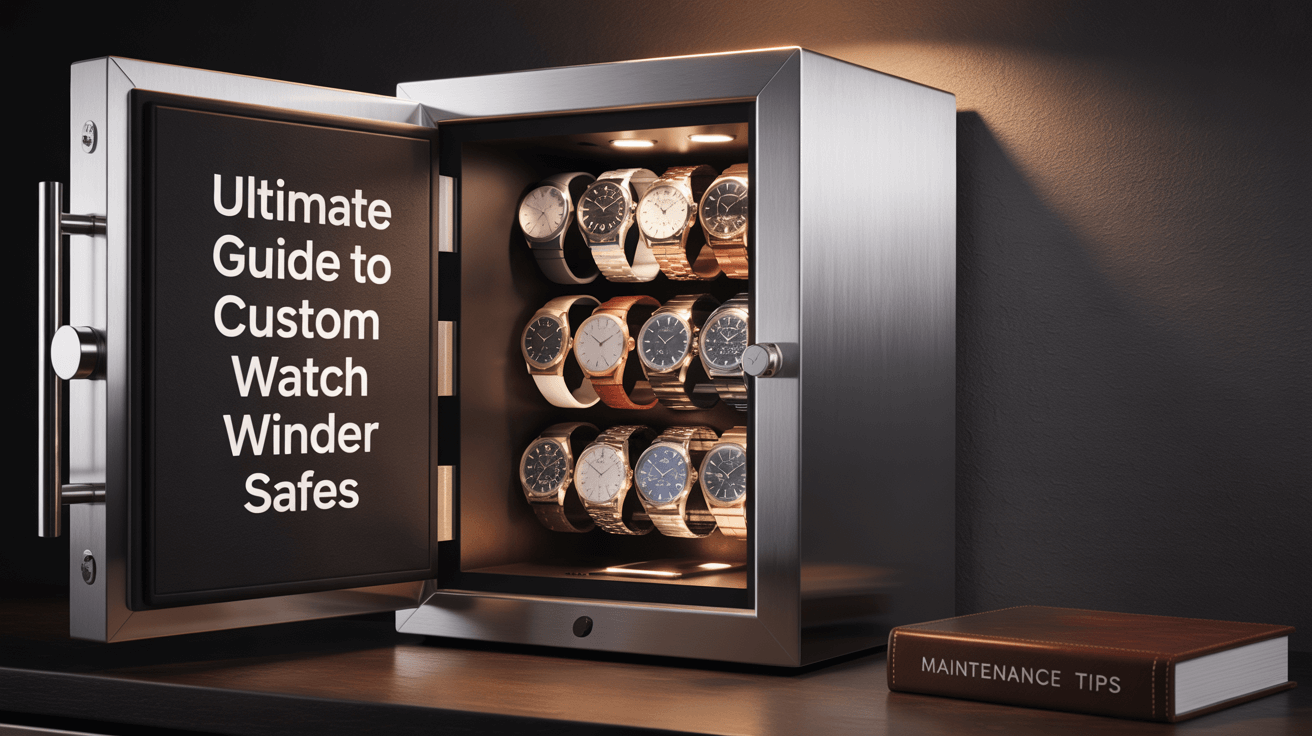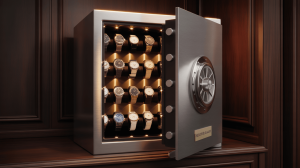Ultimate Guide to Custom Watch Winder Safes: Top Designs & Maintenance Tips. Here’s the deal… A custom watch winder safe offers tailored protection, precise winding, and a showcase that reflects your unique style.
1. Benefits of a Custom Watch Winder Safe
Custom safes combine security with personalized design. You choose capacity, finish, and winding specifications that match your collection. Built-in winders keep automatic watches running on schedule, preventing lubricant stagnation and calendar resets. Modular interiors let you add or rearrange trays for future acquisitions. Investing in a bespoke unit ensures your valuables are both protected and elegantly displayed.
| Benefit | Description | Advantage |
|---|---|---|
| Tailored Capacity | Sized exactly for your watches | No wasted space |
| Customized Finish | Choose veneer, steel, or leather wrap | Matches your décor |
| Precision Winding Specs | Adjustable TPD and direction modes | Protects each movement |
2. Security Features and Certifications
High-security standards are non-negotiable. Look for UL RSC or ETL burglary ratings, which test resistance against drills, pry bars, and impact tools. Multi-bolt locking mechanisms and reinforced steel walls add layers of defense. Biometric or dual-lock options provide both convenience and redundancy. Always verify certification documents to ensure your custom safe meets professional benchmarks.
3. Fire and Climate Protection
Fireboard insulation and intumescent seals protect against high temperatures. Aim for UL 72 Class 350 ratings—30–60 minutes at 1,200 °F—to keep internal temps below 350 °F. Climate-sealed doors (IP54 rating) block dust and moisture. Built-in desiccant chambers or active dehumidifiers maintain ideal 40–50% relative humidity, safeguarding both watch lubricants and precious metals from corrosion.
4. Material and Finish Options
Custom safes offer diverse exteriors: powder-coat steel, brushed stainless, wood veneers (walnut, oak), and premium leather wraps. Select scratch-resistant powders or UV-stable veneers for longevity. Interior linings come in velvet, suede, or carbon fiber finishes. Your choice defines both style and durability.
| Material | Appearance | Durability |
|---|---|---|
| Powder-Coat Steel | Matte contemporary | Scratch-resistant |
| Walnut Veneer | Warm traditional | Must be polished occasionally |
| Leather Wrap | Rich, tactile luxury | Resists light wear |
5. Custom Interior Layouts
Design interiors around your collection. Combine watch pillows, ring rolls, necklace hooks, and winder bays. Removable trays let you switch between winding and static storage. Hidden drawers beneath main trays keep tools and paperwork organized. This level of customization ensures each piece has its own dedicated space, minimizing handling and maximizing presentation.
6. Watch Winder Module Specifications
High-quality modules feature Japanese Mabuchi or Swiss motors. Adjustable TPD ranges from 650 to 2,000 revolutions per day. Directional settings—clockwise, counterclockwise, or bi-directional—and programmable pause intervals prevent overwinding. Removable trays allow you to maintain only active automatics, extending motor life and reducing noise.
7. Noise and Vibration Control
Whisper-quiet operation is essential for bedrooms or offices. Look for rubber-mounted motors and precision bearings rated under 25 dB. Soft-close hinges and silent locking bolts prevent clicks and slams. Effective vibration damping preserves both the safe’s structure and delicate watch movements.
| Feature | Specification | Benefit |
|---|---|---|
| Rubber Motor Mounts | Isolates vibration | Protects movement integrity |
| Precision Bearings | High-tolerance engineering | Under 25 dB noise |
| Soft-Close Hinges | Hydraulic mechanism | Eliminates door slams |
8. Smart Connectivity and Controls
Modern custom safes integrate Bluetooth or Wi-Fi, sending tamper, door-open, and battery-low alerts to your smartphone. Dedicated apps allow remote lock/unlock, winding schedule adjustments, and audit-trail reviews. This connected approach provides real-time peace of mind whether you’re home or away.
9. Power and Backup Solutions
Dual-power setups combine AC adapters with rechargeable battery packs, ensuring continuous operation during outages. Look for low-battery LED alerts or app notifications. Always include a mechanical override key or combination dial as a fail-safe. This layered power strategy guarantees that electronics and winders remain functional under any circumstance.
10. Installation and Anchoring Guidelines
Proper installation transforms your safe into an immovable stronghold. Bolt the unit into floor joists or wall studs using heavy-duty masonry or lag anchors rated for the safe’s weight plus contents. Ensure the safe sits level to prevent door binding. Conceal anchor heads beneath interior liners or trim panels for a flawless appearance.
| Surface Type | Anchor Type | Recommended Bolt Size |
|---|---|---|
| Wood Studs | Lag bolts | ½″ × 6″ |
| Concrete/Brick | Sleeve anchors | ⅜″ × 4″ |
11. Aesthetic Integration into Home Décor
A custom watch winder safe can serve as a furniture centerpiece. Coordinate finishes with existing pieces—choose matching wood veneers or complementary metal tones. Optional lighting accents—LED strips or edge-lit glass—highlight heirloom timepieces. The result is a seamless blend of art and security.
12. Maintenance Schedule and Tips
Regular upkeep extends performance and appearance. Dust the exterior weekly with a microfiber cloth. Test locks and winders monthly. Replace desiccant packs and batteries every 6–12 months. Lubricate mechanical dials per manufacturer guidelines. Check for loose bolts biannually to maintain structural integrity.
13. Troubleshooting Common Issues
Unusual winders’ noise may indicate loose mounts—tighten rubber damping or motor screws. Failing locks often stem from low batteries—replace promptly. Humidity spikes can clog desiccants—reactivate or replace packs. For persistent errors, consult the safe’s support line or authorized technician.
14. Upgrading and Expanding Your Safe
As your collection grows, add extra winder trays, jewelry drawers, or specialized trays for cufflinks and cuff bracelets. Modular safes permit future expansion without full replacement. Consider integrated watch-care kits—cleaning tools and microfiber cloths stored within the safe—for complete convenience.
15. Choosing the Right Manufacturer and Warranty
Select brands with proven track records in luxury security—look for extensive warranties (3–5 years) covering both structure and electronics. Evaluate onsite service options, spare-parts availability, and responsive customer support. A reputable manufacturer ensures your custom safe remains functional and stylish for decades.
Conclusion
A custom watch winder safe merges robust security, tailored winding performance, and sophisticated design. Here’s the deal… use these guidelines to create a vault that protects and showcases your collection with precision and panache.
FAQ
Q1: How often calibrate TPD settings?
Upon installation and after adding new watches—then rarely afterward.
Q2: Can I mix jewelry and watches in the same tray?
Recommended to use separate compartments to avoid scratches and tangling.
Q3: How do I know when to replace desiccant packs?
Monitor humidity display and replace when RH exceeds 50%.
Q4: Are custom veneers durable?
Choose UV-stable, scratch-resistant finishes to minimize maintenance.
Q5: What if I move the safe to a new home?
Re-anchor into new studs or concrete; verify level and bolt tightness after relocation.
How to Choose the Perfect Custom Watch Winder Safe for Your Collection. But here’s the kicker… A bespoke winder safe tailors security, winding performance, and style exactly to your needs, ensuring every piece in your collection stays safe, accurate, and beautifully displayed.
1. Define Your Collection Needs
Start by cataloging each watch’s type, case diameter, and winding requirements. Note how many automatics need winding versus static storage. Decide if you also want dedicated jewelry compartments or tool drawers. Mapping current and future acquisitions reveals the precise capacity you need. Use this clarity to avoid wasted space and ensure your custom safe fits your collection like a glove.
| Collection Size | Watch Count | Storage Recommendation |
|---|---|---|
| Small | 1–4 watches | Compact winder trays |
| Medium | 5–8 watches | Mix of winders and pillows |
| Large | 9+ watches | Modular trays + jewelry drawers |
2. Determine Security and Certification Requirements
Your custom safe should meet recognized security standards. UL RSC or ETL burglary certifications guarantee resistance against common forced-entry tools. A multi-bolt steel door with concealed hinges adds layers of defense. If fire risk is a concern, aim for UL 72 Class 350 fire ratings to keep interior temps under 350 °F for at least 30 minutes. These certifications validate your safe’s ability to protect high-value timepieces and jewelry.
3. Balance Fire and Climate Protection
Beyond burglary, extreme heat, humidity, and dust threaten movements and metal finishes. Composite fireboard linings and intumescent seals block heat and smoke. Climate-sealed doors (IP54) prevent moisture ingress. Built-in desiccant chambers or active dehumidifiers maintain relative humidity between 40–50%. This balanced protection preserves lubricants, prevents strap drying, and stops tarnish, ensuring your watches and jewelry remain pristine.
4. Choose Exterior Materials and Finishes
Select materials that blend with your décor and offer durability. Options include powder-coat steel, brushed stainless, wood veneers (walnut, oak), or leather wraps in custom colors. High-quality veneers resist warping, while UV-stable powders prevent fading. Your finish choice defines the safe’s presence in any room—whether it’s a modern office or traditional library.
| Material Option | Visual Style | Durability |
|---|---|---|
| Powder-Coat Steel | Matte contemporary | Scratch and fade resistant |
| Brushed Stainless | Modern industrial | Corrosion-resistant |
| Walnut Veneer | Warm traditional | Requires occasional polishing |
5. Select Interior Organization Features
A modular interior keeps each piece secure and accessible. Customize adjustable foam inserts, velvet-lined watch pillows, ring rolls, and necklace hooks. Include removable trays for future expansion. Hidden drawers beneath the main layout store straps, tools, and paperwork out of sight. Thoughtful organization reduces handling wear and creates a refined presentation.
6. Evaluate Locking Mechanism Options
Lock choices impact convenience and reliability. Mechanical dials never require power but operate at moderate speed. Electronic keypads offer multiple user codes, time-delay functions, and audit logs. Biometric scanners grant instant fingerprint access but need re-enrollment. Dual-lock safes combine two methods for maximum security. Match lock type to your daily routine and comfort with technology.
7. Customize Watch Winder Module Specifications
Tailor winding parameters to each movement. High-end modules feature adjustable turns-per-day (650–2,000), directional controls (clockwise, counterclockwise, or bi-directional), and programmable pause intervals. Precision Japanese or Swiss motors rated under 25 dB ensure whisper-quiet, low-vibration operation. Removable trays let you wind only active automatics, conserving motor life and energy.
| Specification | Range/Option | Benefit |
|---|---|---|
| TPD Setting | 650–2,000 rpm/day | Matches manufacturer specs |
| Direction Control | CW, CCW, Bi-directional | Prevents over-winding |
| Noise Level | < 25 dB | Silent home or office use |
8. Consider Noise and Vibration Control
Even subtle hums or rattles can become distractions. Rubber-damped motor mounts absorb vibration, while precision bearings maintain quiet operation. Soft-close hinges and silent locking bolts eliminate slamming or clicks. These refinements let your safe operate discreetly in bedrooms, offices, or shared living spaces without disturbing the peace.
9. Plan Smart Connectivity and Remote Monitoring
Integrate Bluetooth or Wi-Fi modules for real-time alerts. Receive tamper, door-open, and low-battery notifications on your smartphone. Apps allow remote lock/unlock, winding schedule adjustments, and viewable audit logs of each access event. This connected approach delivers peace of mind whether you’re at home or traveling abroad.
10. Account for Power Supply and Backup Options
Ensure continuous operation with dual-power designs. Primary AC adapters provide steady energy, while rechargeable battery packs serve as emergency backups. Look for low-battery LED indicators or app notifications. Always maintain a hidden mechanical override key or dial for manual access if electronics fail.
| Power Source | Backup Method | Maintenance |
|---|---|---|
| AC Adapter | — | Annual visual check |
| Rechargeable Battery | Manual override key | Recharge every 6–12 months |
| USB-C Auxiliary | Hidden override PIN | Inspect cable quarterly |
11. Plan Installation and Anchoring Methods
Proper anchoring transforms your safe into an immovable fixture. Locate floor joists or wall studs with a stud finder. Use heavy-duty lag or sleeve anchors rated for the safe’s weight plus contents. Level the safe before tightening bolts to avoid door binding. Conceal anchor heads under interior liners or trim for a clean, finished look.
12. Ensure Adequate Lighting and Display
Integrated LED strips or fiber-optic spotlights highlight each watch and jewelry piece without generating heat. Choose warm white to accent gold and leather, or cool white to showcase steel and gems. Motion sensors activate lights on door opening, conserving battery power and creating a dramatic reveal.
13. Budgeting and Value Prioritization
Custom safes range widely in price. Entry-level options start around $1,000 for basic bespoke features; mid-range units ($2,000–$5,000) add advanced winders and climate controls; premium models ($5,000+) include full smart integration and exotic finishes. Prioritize security certifications and winding performance before optional extras like bespoke engraving or exotic veneers.
| Budget Tier | Price Range | Core Features |
|---|---|---|
| Entry-Level | $1,000–$2,000 | Custom size + basic winders |
| Mid-Range | $2,000–$5,000 | Climate control + smart alerts |
| Premium | $5,000+ | Exotic finishes + full IoT |
14. Plan Maintenance and Upkeep Scheduling
Regular maintenance preserves functionality and appearance. Dust exterior panels monthly with a microfiber cloth. Test locks and winders quarterly. Replace desiccant packs and batteries every 6–12 months. Lubricate mechanical dials per manufacturer guidelines to ensure smooth operation. Keep a log of service dates to avoid lapses.
15. Final Selection and Setup Tips
Compile your criteria—capacity, security certifications, fire and climate ratings, lock type, winder specs, noise level, connectivity, power options, finish, budgeting, and maintenance—into a comparison chart. Score top custom proposals to choose the perfect safe. Coordinate delivery and professional installation to enjoy a seamless setup experience.
Conclusion
Choosing a custom watch winder safe means harmonizing security, precision winding, and personalized style. But here’s the kicker… with these guidelines, you’ll create a bespoke vault that safeguards and showcases your collection flawlessly for years to come.
FAQ
Q1: How often should I adjust TPD settings?
Once per watch upon setup, then only if you add new automatics.
Q2: Can I mix jewelry and watches in one drawer?
Recommended to use separate compartments to prevent scratches.
Q3: How do I know when to replace desiccant packs?
Replace when humidity rises above 50% on the digital hygrometer.
Q4: Are custom veneers prone to damage?
Select UV-stable, scratch-resistant finishes to minimize wear.
Q5: What if I relocate my safe?
Re-anchor into new studs or concrete and verify level before use.







